How to make your own sustainable cleaning products

Wondering how to make your own sustainable cleaning products? Our friends at Ethical.net are here to help, with useful tips galore and a recipe for homemade apple cider vinegar.
Living a more sustainable life involves not only thinking carefully about all your purchases, but also about reducing your consumption overall. There are a number of ways to do this: growing your own food, for example, and learning traditional skills to help you make rather than buy things. Making your own eco-friendly cleaning supplies is another way to reduce what you need to buy, and to live in a greener and more ethical way.
Why make your own sustainable cleaning products?
When it comes to cleaning your home, there are plenty of reasons to make things simpler and greener by using natural products:
- It will help you avoid bringing harmful chemicals into your home, or releasing them into the wider environment
- It will reduce your carbon footprint, by reducing the amount you buy and how far they have to travel to reach you
- You can reduce the amount of plastic packaging you bring into your home, and move closer to a zero-waste lifestyle. The plastic bottles and other packaging used for household cleaning products are often not recyclable, and even when they are, won’t always be disposed of correctly.
- If you or anyone in your family has sensitive skin, natural cleaning products can be better to clean with, as well as for washing clothes
- Making your own cleaning products can also save you a lot of money
- What’s more, making them can be a lot of fun!
So, let’s take a look at the simple products we can use to clean our homes.
Bicarbonate of soda
If you buy only one ingredient for cleaning your home, this simple, versatile ingredient is the one to choose. Bicarbonate of soda is amongst the best natural cleaning products as it can be used for a wide range of household cleaning jobs. It is fragrance-free and it can be used on its own, though it is often used in combination with apple cider vinegar (or other vinegar), or with certain infused oils or essential oils such as peppermint, tea tree, orange, lemon or lavender for fragrance.
Cleans
Bicarbonate of soda is great for cleaning everything from surfaces, to ovens, to dishes. Use it along with vinegar to clean even the most stubborn grease; you will be surprised by how effective it is at cleaning away dirt, making your house clean and fresh-smelling. Simply mix some of the powder with a little water to make a paste, and use this as a surfactant to clean dishes, sinks, or kitchen worktops.
In place of conventional laundry detergents, bicarbonate of soda will wash your clothes perfectly effectively, while also softening water, increasing the life of appliances in hard water areas. If you require a scent to your clothing a little organic bar soap mixed into a solution (see below), or a few drops of essential oil (again, see below) will do the trick, while vinegar makes a great fabric softener. But all you really need for clean, fresh clothes is bicarb – whether you are washing in a machine or by hand.
Removes unpleasant smells
Bicarbonate of soda not only cleans, it can also get rid of unpleasant smells. The natural pH-balancing properties of baking soda have the effect of neutralising odours, rather than just covering them up. Sprinkle some in your fridge (or leave an open box in there) to prevent nasty odours, and sprinkle on carpets or upholstery to remove stubborn smells. It can even be used on pets to make them smell fresher, or inside stinky old shoes!
Apple cider vinegar
A natural disinfectant, vinegar is another key ingredient for a simpler non-toxic cleaning regime – and you might not even have to buy it: various types of vinegar can be cheaply and easily made at home. Apple cider vinegar is the simplest!
Making apple cider vinegar
All you need are some apples – bonus points if you grow your own! Whether home-grown or bought from a local producer, you needn’t even use the whole apples; vinegar can be made from waste cores.
Simply:
- Place apple cores in a glass jar, and cover them with water
- Add a little sugar to speed up the process
- Place something like a stone in the top of the jar to hold the cores under the water, and cover with a muslin square or paper towel held in place with an elastic band

- Keep the jar or jars in a cool, dark place, checking for bad, dark moulds. (You should see a clear, white scum instead.) If a dark mould does appear, skim it off, but try to leave the white scum in place. (This is only true for cleaning purposes; if you plan to consume the vinegar you may prefer to err on the side of caution and throw the batch away.)
- After around a month, strain the liquid to remove the cores and apple pieces, then replace the liquid into its jars and re-cover
- Return the jars to a cool, dark place for another month or two
- After around a month, check for acidity by smell and taste; use when vinegary by pouring it into a spray bottle and you have your multi-surface cleaner!
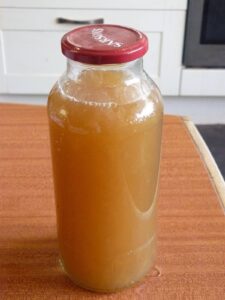
Remember, though using this for cleaning, apple cider vinegar is also great for a range of culinary uses, and for conditioning your hair.
Using apple cider vinegar to clean your home
Apple cider vinegar is gentler than white vinegar, and has a more pleasant smell. It can cut through grease and grime and kill harmful bacteria just as effectively as the strong, toxic cleaners on the market. Mix into a paste with bicarbonate of soda to give surfaces or cooking pans a scrub, and you’ll get off even the most stubborn grease and grime. Spread this paste overnight inside your oven, and in the morning it will be much easier to scrub clean.
Windows and other glass items around your home can be cleaned using just water, vinegar, and some newspaper or piece of old towelling. Put a solution of one third vinegar to two thirds water into a plant sprayer and squirt it onto the glass, then wipe the dirt away with the newspaper or towelling. You can also add some vinegar into your dishwasher and observe how it makes your wine glasses shine.
Bathroom and kitchen
An old-fashioned mop and pail works perfectly to clean the floor in a bathroom or kitchen, and rather than buying a floor cleaner just fill your pail with hot water, a small amount of vinegar, and a shake of bicarb. This mixture will fizz and then settle; give it a stir, then mop as usual. Your floor will be completely clear: the vinegar will kill germs, and the soda will get rid of lingering odours.
Think it would be revolting to not use bleach and other harsh chemicals when disinfecting your toilet? Worried about germs and smells? When combined soda and vinegar make a powerful stain remover and disinfectant. Tip some into your toilet bowl, give it a go with a toilet brush and flush. In a week you’ll see that your toilet remains stain and odour-free under this new regime. Vinegar is also a great glass cleaner, simply spray onto your mirror and wipe with a dry cloth.
As you can see, these two simple ingredients are all you really need to clean everything in your home – yet some people find it hard to transition to this simpler approach. A common complaint is that people miss the artificially fragrant smells of chemical household cleaners. Smelling ‘clean’ or ‘fresh’ just doesn’t seem enough.
Always read warning labels on products
If you read the products’ warning labels, you may be shocked. Many household cleaning products are harmful to aquatic life, disrupting reproductive cycles or otherwise affecting their ability to live. Even when products are not labelled as hazardous, they may still be damaging to the environment – either during their manufacture or when in use. And then there are their plastic containers, which will endure in the environment, posing a threat to marine creatures and ecosystems, before ultimately breaking down and hazardously entering the food-chain.
We have become conditioned to think that a clean house shouldn’t just smell neutral, but should have a pleasant fragrance. There’s nothing wrong with that – but rather than choosing harmful and polluting cleaners and air-fresheners, use simple, natural ingredients to make your home smell great instead.
Infused oils and essential oils
Many herbs and flowers that could easily be grown in your garden (or even on a sunny windowsill) can also be used to make infused or essential oils, to add fragrance to your home. Which type you make will depend on how much growing space you have available, and on how much time, money, and effort you are willing to invest.
Making essential oils involves a distillation process, requiring a still – specialist equipment. You’ll also need to grow a lot of one particular herb or flower to make even a small amount. Of course, you could simply buy natural, organic essential oils to use in cleaning your home and making it fragrant, but there is another option:
Infused oils use a carrier oil (sweet almond or coconut oil, for example) to carry the herb or flower’s fragrance and other beneficial properties. Simply put some herbs or flowers into a jar, cover them with oil and wait (at least a month) for the mix to infuse – then sieve. You can accelerate the process by heating the oil while the herbs or flowers are in it, but this may result in an inferior end result.
Though not as intense or therapeutic as essential oils, infused oils have a wide range of uses around your home – in cleaning products for both yourself and your interiors and belongings. For example, add a little oil to a diffuser to spread fragrance through your living room, wipe some over wooden surfaces, or put a few drops in with your clothes or bedding in the wash.
Natural soaps
Bar soaps (hand soaps) are far better for sustainable cleaning than liquid ones; they don’t require bottles, and usually last a lot longer. Infused or essential oils can be a key ingredient in a range of DIY bar soap recipes available online, which explain production using both hot and cold processes.
These days, we tend to think of bar soap as something to clean ourselves with – but a natural bar soap can also be used to clean our homes. For example, you could rub some on a scrubbing brush or mop to clean your floors, or shave some flakes into your clothes wash along with the bicarbonate of soda. You can even make your own dish soap with olive oil and lemon juice for your dishes, or use a mix of hot water, olive oil and lemon juice as a great wood cleaner for wooden floors.
Soap plants
Interestingly, there are even natural ‘soap plants’ which can be used for cleaning without any complicated processing. For example, both the leaves and the roots of soapwort (Saponaria officinalis) are high in saponins, a substance which creates a lather in water and can be used as a surfactant in place of modern soaps and detergents. Take care since soapwort can irritate the eyes, but it can be extremely useful away from the face: rub some leaves on your hands as a quick alternative to soap, or blend roots with water and strain to create an all-natural liquid soap or detergent.

Clematis, another plant often grown in the UK, is also high in saponins; a simple natural soap can be made from its leaves and flowers. Like soapwort, this plant was used by Native Americans and other indigenous peoples as a natural cleanser; it can be used to wash dishes, or as a rinse for surfaces around your home.
If you grow yucca as a houseplant, you may be interested to know that its root is high in saponins. Of course, taking the root will kill the plant, but if you pound and soak the leaves, you can use them to make fibre, while soaking water will contain sufficient saponins for washing clothes.
Cheap, natural and readily available
As you can see from the above, there is no need to resort to harmful, plastic-packaged household cleaners in your home. Natural cleaners are cheap and readily available, so there is no excuse not to switch over to a natural cleaning regime today. If you can’t find the time to make your own natural cleaning products, you can check out natural cleaning products available to buy.
Sustainability need not always be about looking forward, grasping towards new technologies that may or may not save the day. Innovation is important, and will play an important role in defining our future. But sometimes we need to look backwards; making household cleaning products would be nothing new to our forebears: only a few generations ago, this was the norm. Re-learning skills that have largely been lost is also an important method for forging a better, more ethical, and sustainable future. Sometimes, our great, great grandparents did know best.
Shared and adapted from an original article by Elizabeth Waddington here on the Ethical.net blog. Featured image by Chiot’s Run via Flickr. Find more about making your own natural cleaning products here.
 About the author
About the author
Ethical.net is a collaborative platform for discovering and sharing ethical alternatives, whether purchasing from a social enterprise, thrift shopping, or learning how to fix your old phone instead of buying a new one. They aim to make ethical the new normal.
The views expressed in our blog are those of the author and not necessarily lowimpact.org's
3 Comments
-
1annbeirneanimalwhisperert May 6th, 2020
I have made my own natural cleaners for some time but I hadn’t thought of Clematis as have saponins, I already grow soapwort in my garden, and make my own soap I use glass spray bottles not plastic one as we are eliminating as much plastic from our house and garden as possible, they are great and will last forever unless they get broken of course.
-
2it.wisnaemoi May 6th, 2020
Great article Sarah. I am using Food Grade Hydrogen Peroxide for household cleaning – would welcome any comments you have about that. I am happy with it, but it is expensive.
-
3find a contractor June 23rd, 2020
These are very effective tips, thanks for sharing this! I do woodcarving and value my furniture very much, as I put my work and time into it. But it so happened that when I was cleaning, the coating on the furniture deteriorated due to chemicals that were planted in the cleaning agent. It always upset me and had to repaint the furniture after a while. But the soda method really helped, and it didn’t ruin the surface. Thank you for sharing!




 New, cheap tap fitting that does seem to save water without causing flow problems
New, cheap tap fitting that does seem to save water without causing flow problems
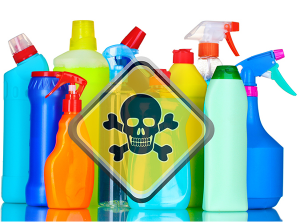 Ditch the bleach: switch to natural cleaning to avoid toxins and carcinogens
Ditch the bleach: switch to natural cleaning to avoid toxins and carcinogens
 Why the ‘natural’ in natural soaps is so important
Why the ‘natural’ in natural soaps is so important
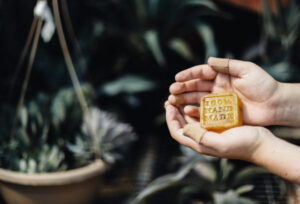 Great ways to reduce plastic use in your home: Part 2 – cleaning products and toiletries
Great ways to reduce plastic use in your home: Part 2 – cleaning products and toiletries
 Eco-friendly laundry: 12 easy tips to reduce your environmental impact
Eco-friendly laundry: 12 easy tips to reduce your environmental impact
 Essential oils
Essential oils
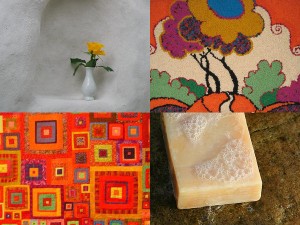 Low-impact homes
Low-impact homes
 Natural cleaning
Natural cleaning
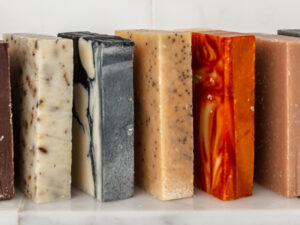 Natural soaps
Natural soaps


